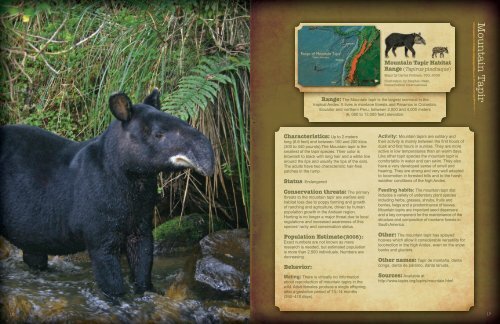About Tapirs - Tapir Specialist Group
About Tapirs - Tapir Specialist Group
About Tapirs - Tapir Specialist Group
Create successful ePaper yourself
Turn your PDF publications into a flip-book with our unique Google optimized e-Paper software.
Mountain <strong>Tapir</strong> Habitat<br />
Range (<strong>Tapir</strong>us pinchaque)<br />
Maps by Carlos Pedraza, TSG, 2008<br />
Illustration by Stephen Nash,<br />
Conservation International<br />
Range: The Mountain tapir is the largest mammal in the<br />
tropical Andes. It lives in montane forests and Paramos in Colombia,<br />
Ecuador and northern Peru, between 2,000 and 4,000 meters<br />
(6, 000 to 13,000 feet) elevation.<br />
Characteristics: Up to 2 meters<br />
long (6.6 feet) and between 150 and 200 kilos<br />
(300 to 440 pounds).The Mountain tapir is the<br />
smallest of the tapir species. Their color is<br />
brownish to black with long hair and a white line<br />
around the lips and usually the tips of the ears.<br />
The adults have two characteristic hair-free<br />
patches in the rump.<br />
Status: Endangered<br />
Conservation threats: The primary<br />
threats to the mountain tapir are warfare and<br />
habitat loss due to poppy farming and growth<br />
of ranching and agriculture, driven by human<br />
population growth in the Andean region.<br />
Hunting is no longer a major threat due to local<br />
regulations and increased awareness of this<br />
species’ rarity and conservation status.<br />
Population Estimate(2008):<br />
Exact numbers are not known as more<br />
research is needed, but estimated population<br />
is more than 2,500 individuals. Numbers are<br />
decreasing.<br />
Behavior:<br />
Mating: There is virtually no information<br />
about reproduction of mountain tapirs in the<br />
wild. Adult females produce a single offspring<br />
after a gestation period of 13–14 months<br />
(390–410 days).<br />
Activity: Mountain tapirs are solitary and<br />
their activity is mainly between the first hours of<br />
dusk and first hours in sunrise. They are more<br />
active in low temperatures than on warm days.<br />
Like other tapir species the mountain tapir is<br />
comfortable in water and can swim. They also<br />
have a very developed sense of smell and<br />
hearing. They are strong and very well adapted<br />
to locomotion in forested hills and to the harsh<br />
weather conditions of the high Andes.<br />
Feeding habits: The mountain tapir diet<br />
includes a variety of understory plant species<br />
including herbs, grasses, shrubs, fruits and<br />
berries, twigs and a predominance of leaves.<br />
Mountain tapirs are important seed dispersers<br />
and a key component for the maintenance of the<br />
structure and composition of montane forests in<br />
South America.<br />
Other: The mountain tapir has splayed<br />
hooves which allow it considerable versatility for<br />
locomotion in the high Andes, even on the snow<br />
banks and glaciers.<br />
Other names: <strong>Tapir</strong> de montaña, danta<br />
conga, danta de páramo, danta lanuda.<br />
Sources: Available at<br />
http://www.tapirs.org/tapirs/mountain.html<br />
16 17<br />
Mountain <strong>Tapir</strong>










